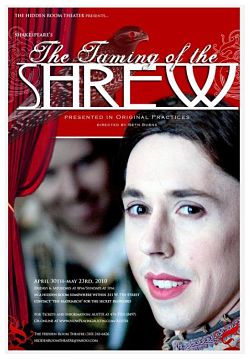Review: The Taming of the Shrew, original practices by Hidden Room Theatre
by Michael Meigs
The excitement and cameraderie were palpable on the opening night of the Hidden Room Theatre's "original practices" staging of The Taming of the Shrew. This was a gathering of Austin's acting fellowship, in the audience as well as among the company. Director Beth Burns and assistant director Stephanie Delk greeted familiar faces; storyteller-actress Bernadette Nason served the refreshments; musician Jennifer Davis of the Baron's Men offered masks for sale at the concession stand. After the house was opened, the animation and anticipation were so great that one of the town's most appreciated Shakespearian actors managed to spill his white wine in front of the seats on the south side. Director Beth Burns took the mishap in good humor and went down on her knees with a towel, scrubbing to make sure the playing space was dry and safe.
One fellowship was assembled within the meeting hall of another, for Burns had obtained the gracious permission of a masonic order to use its space in a historic downtown building to create a court theatre like that of Shakespeare's royals.
A consort of ten musicians led by Jennifer Davis provided enchanting period music with voice, recorder, stringed instruments and percussion, both before the play and at intervals throughout.
The Taming of the Shrew opens with an Induction or prologue, often abandoned today. An aristocrat returning from the hunt discovers the drunkard Christopher Sly passed out in the street. The lord and his serving men bring Sly into comfortable quarters. They fool him into believing that he himself is a great lord and they offer him the company of a wench, impersonated by Bartholomew, a male page. Sly wants to go to bed with his new lady but agrees to the diversion of a pleasant comedy -- the story of Katherina Minola and Petruchio.
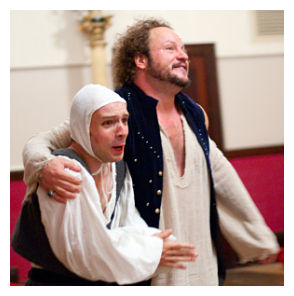 Keeping the Induction and playing the cross-dressing masquerade to the hilt provides a subtle bit of irony for this production. Big Robert Deike provides us a Sly who's loud, sloppy and clownish. Justin Scalise, with wide eyes and snugged kerchief, is a tender young man in dire danger of some misdirected physical attention. Sly is the opposite of sly; Bartholomew is the opposite of a lord's lady; and the pleasant comedy will be the opposite of Sly's expectations ("Is not a comonty [comedy] a Christmas gambold, or a tumbling-trick?").
Keeping the Induction and playing the cross-dressing masquerade to the hilt provides a subtle bit of irony for this production. Big Robert Deike provides us a Sly who's loud, sloppy and clownish. Justin Scalise, with wide eyes and snugged kerchief, is a tender young man in dire danger of some misdirected physical attention. Sly is the opposite of sly; Bartholomew is the opposite of a lord's lady; and the pleasant comedy will be the opposite of Sly's expectations ("Is not a comonty [comedy] a Christmas gambold, or a tumbling-trick?").
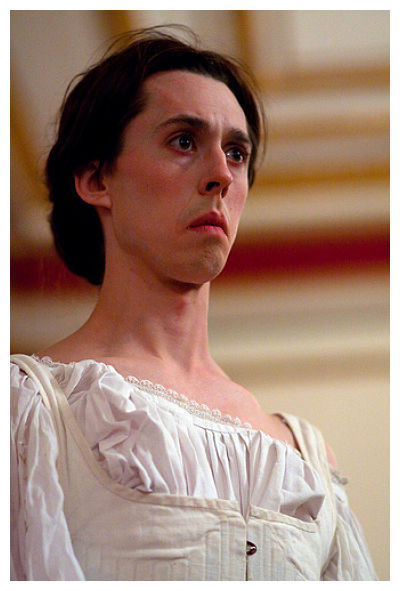 In this staging, Justin Farris as Petruchio is cheery, smart and decisive, unlike Christopher Sly. Ryan Crowder plays Kate as assured, justly indignant and handsomely feminine, unlike Scalise's Bartholomew. A modern audience intrigued by the "original practices" convention of males playing all female roles gets its giggles out with Sly and Bartholomew the page, then settles into close attention to the familiar story. Crowder as Kate and Ryan Hamilton as sister Bianca play those roles without mockery or self consciousness, and we accept them as those female characters.
In this staging, Justin Farris as Petruchio is cheery, smart and decisive, unlike Christopher Sly. Ryan Crowder plays Kate as assured, justly indignant and handsomely feminine, unlike Scalise's Bartholomew. A modern audience intrigued by the "original practices" convention of males playing all female roles gets its giggles out with Sly and Bartholomew the page, then settles into close attention to the familiar story. Crowder as Kate and Ryan Hamilton as sister Bianca play those roles without mockery or self consciousness, and we accept them as those female characters.
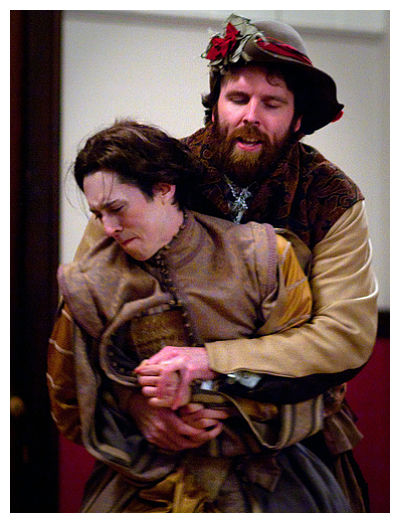 Ryan Crowder deserves special applause. His Katherina is an intelligent woman, neglected and misprised by her father in favor of Hamilton's self-absorbed Bianca. She is tart, rather than sour, and gradually we see her beginning to appreciate Petrucio's attentions.
Ryan Crowder deserves special applause. His Katherina is an intelligent woman, neglected and misprised by her father in favor of Hamilton's self-absorbed Bianca. She is tart, rather than sour, and gradually we see her beginning to appreciate Petrucio's attentions.
Burns has attracted players with lots of experience in Shakespeare. Their delivery of the verse is vigorous, well paced and easy to grasp. This company features actors who've played recently with Austin Shakespeare, the Baron's Men, the City Theatre, the EmilyAnn, Penfold Theatre, the Sam Bass Community Theatre, and the Scottish Rite Theatre.
An "original practices" production reminds one that theatre is a participatory art, a pact of make believe between the players and their public. This hidden room offered essentially no scenery, other than chairs and a table carried on and off, as needed. Period costuming set scenes and defined charactes. The long hall, oriented east-west, featured slightly raised platforms at either end and some massive, uncomfortable looking seats for dignitaries, used by the actors. The audience settled in ranks of ordinary seating along the length of the space. Action swept in from doors at the west end, while Deike as Christopher Sly presided and at times appeared to drift into sleep in the throne at the opposite end.
Actors acknowledged the audience, addressing them directly at times. For example, for a time Rommel Sulit as Tranio carried on a winking and waving flirtation with a woman seated to our right. Casey Weed as one of Petruccio's serving men enticed my wife and me to waggle our fingers in imitation of crackling flames, and Brock England as Grumio happily warmed his backside before us, to the amusement of all.
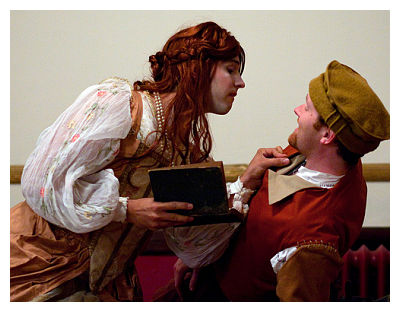 Among other favorites were yellow-jacketed Nathan Jerkins as the Induction's mocking nobleman and as Hortensio the doleful suitor; Benjamin Summers as suitor Lucentio, surprised to find himself outmaneuvered by his love Bianca; and Scot Friedman with a wide grin and later a deprecating grimace as the pedant who masquerades as Lucentio's father.
Among other favorites were yellow-jacketed Nathan Jerkins as the Induction's mocking nobleman and as Hortensio the doleful suitor; Benjamin Summers as suitor Lucentio, surprised to find himself outmaneuvered by his love Bianca; and Scot Friedman with a wide grin and later a deprecating grimace as the pedant who masquerades as Lucentio's father.
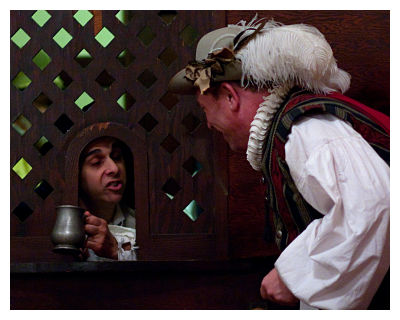 This evening performance used only the incandescent lighting of the chandelier and wall sconces already installed in the hall. Kimberley Mead's photos of dress rehearsal are striking but they have a deceptively bright quality to them. Immediately after the performance I was thinking I'd have preferred some heretical use of theatrical lighting. A technical concession along those lines would have had costs and limitations, however, and the players would not have been free to use the full space as they wished. As it was, we could see them equally well -- or equally poorly -- wherever in the space they were acting.
This evening performance used only the incandescent lighting of the chandelier and wall sconces already installed in the hall. Kimberley Mead's photos of dress rehearsal are striking but they have a deceptively bright quality to them. Immediately after the performance I was thinking I'd have preferred some heretical use of theatrical lighting. A technical concession along those lines would have had costs and limitations, however, and the players would not have been free to use the full space as they wished. As it was, we could see them equally well -- or equally poorly -- wherever in the space they were acting.
Neither the director nor the company raised the modern issue of the misogyny of Shakespeare's plot. In agreeing to convene with them in their hidden room, we gave the bard license to remain part of his time. We listened, laughed, sympathized, and enjoyed an evening of the best vintage.
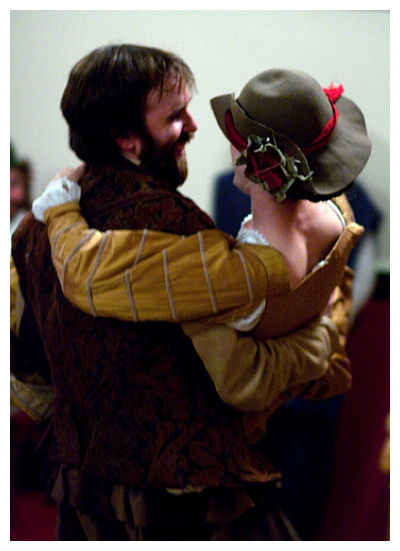
Review by Clare Carnavan for Statesman's Austin 360 "Seeing Things" blog, May 3
Review by Ryan E. Johnson at examiner.com, May 10
Review by Robert Faires in the Austin Chronicle, May 13
Comments by webmaster, TheatreAustin, Yahoo groups, May 20
Spike Gillespie's rave review, regretting she didn't see the production earlier, May 22
EXTRAS
ALT Profile: Preparing Shakespeare "Original Practices" in the Hidden Room, April 27
Click to view the program of The Taming of the Shrew by the Hidden Room Theatre
Hits as of 2015 03 01: 4157
The Taming of the Shrew, original practices
by William Shakespeare
Hidden Room Theatre
